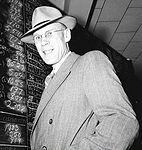| |||||||||||||||||||||||||||||||||||||||||||||||||||||
57 seats in the Legislative Assembly of Alberta 29 seats were needed for a majority | |||||||||||||||||||||||||||||||||||||||||||||||||||||
|---|---|---|---|---|---|---|---|---|---|---|---|---|---|---|---|---|---|---|---|---|---|---|---|---|---|---|---|---|---|---|---|---|---|---|---|---|---|---|---|---|---|---|---|---|---|---|---|---|---|---|---|---|---|
| |||||||||||||||||||||||||||||||||||||||||||||||||||||
| |||||||||||||||||||||||||||||||||||||||||||||||||||||
The 1948 Alberta general election was held on August 17, 1948, to elect members of the Legislative Assembly of Alberta.
Ernest C. Manning led the Social Credit to a fourth term in government, increasing its share of the popular vote further above the 50% mark it had set in the 1944 election. It won the same number of seats — 51 of the 57 seats in the legislature — that it had won in the previous election.
The remaining seats were won by the Cooperative Commonwealth Federation, the Liberal Party and independents.
This provincial election, like the previous five, saw district-level proportional representation (Single transferable voting) used to elect the MLAs of Edmonton and Calgary. City-wide districts were used to elect multiple MLAs in the cities. All the other MLAs were elected in single-member districts through Instant-runoff voting.
Along with this election, voters got to also vote in a province wide plebiscite. The ballot asked voters about utility regulation.

